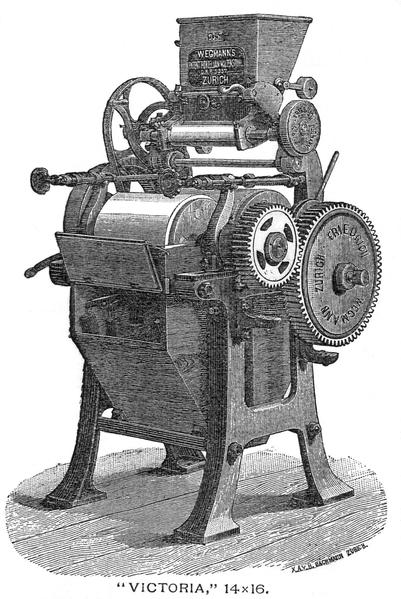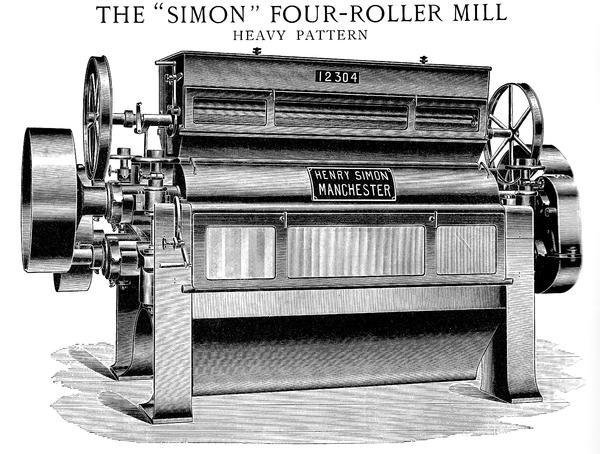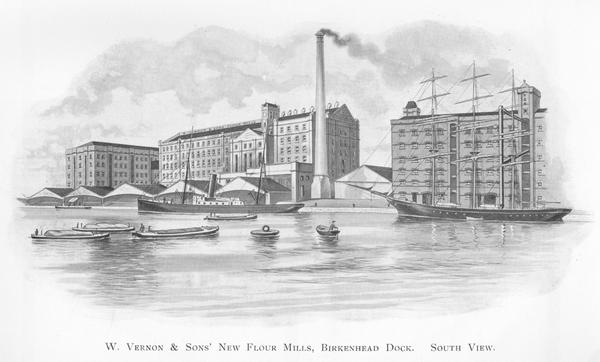| From Quern to Computer; a history of flour milling by Martin and Sue Watts covers a wide range of topics and this summarises Chapter 10. The principle of roller milling is the gradual reduction of grain by breaking it open and reducing the particle size between successive pairs of rolls. At every stage of the process some flour is produced which is extracted in order to obtain the maximum amount of white flour. As Elizabeth David wrote, ‘with the invention of the roller mill… the long search for a means of producing a uniformly white flour was over’. | |

(The Miller, 5 May 1890) (MWAT-025)
| The application of rolls for grinding wheat for flour was slow to gain momentum in Britain, however. The earliest combined roller and stone mill in Britain was probably that designed by Gustav Buchholz for Fison and Co. in Ipswich in 1862. Buchholz’s system was also tried at W. Baker and Son’s mill at Redcliffe Back, Bristol and the Albert Mills in Liverpool were similarly set up with rolls and stones in 1868, but in 1870 the millstones were replaced by partially grooved rolls. This was not only the first complete roller mill in the country but also the first to export roller-milled flour to America. | |

In 1874 Friedrich Wegmann from Naples patented an adjustable porcelain roller mill, which was first installed in the Walzmühle. Wegmann’s rolls, which it was claimed were more efficient than iron or steel rolls, were intended for reducing semolina and middlings (the bran, fibre and germ) prior to stone milling, for which it proved a reliable workhorse. By 1877 porcelain rolls were in use in British mills where initially they proved popular. An advertisement in the trade magazine The Miller in February 1878 listed 100 customers and the New Phoenix Flour Mills, Newcastle, at one time had 20 pairs of stones and 28 pairs of Wegmann rolls.
Although the popularity of porcelain rolls was short-lived as they required considerably more maintenance than iron rolls, Wegmann is generally credited with providing a much needed stimulus to the roller milling industry. By the 1870s roller milling was beginning to gather momentum in Britain. Over the course of the next quarter century flour milling underwent a radical transformation as technology changed and advanced at a pace comparable to today’s computer technology, with machines being rapidly superseded by newer versions.
Image: Wegmann’s ‘Improved “Victoria” Porcelain Roller Mill’
(The Miller, 4 January 1886) (MWAT-043)
| In 1878, the National Association of British and Irish Millers (nabim) was formed for ‘mutual advancement and protection’ in the light of the ‘great changes which are now in progress in the manufacture of flour, and in the machinery used for that purpose’. These ‘great changes’, witnessed in the articles and advertisements in The Miller, were driven by two related factors: the growing demand for white bread and the increased importation of hard wheats from North America, Russia and also Australia and India, to meet demand. These hard wheats gave good quality flours, naturally higher in gluten than native soft wheats, which enabled the production of well-risen white bread. The gradual reduction method employed by the new roller mills was not only better suited to milling hard wheats than traditional millstones, but also to extracting a greater proportion of fine white flour. In addition, changes were taking place in the location of the milling industry, as large new mills were built at ports and on navigable rivers and canals, well-placed to receive deliveries of imported wheat. Such changes were also facilitated by the use of steam power. The main players were engineering companies such as Henry Simon, J. Harrison Carter, E.R. & F. Turner and Thomas Robinson and Son, who developed their own roller milling systems with associated cleaning and dressing machinery. However, there were also a number of smaller concerns such as Whitmore & Binyon, William Gardner, W.R. Dell and J. Hopkinson who had started out supplying the stone milling industry and now also catered for the roller milling business. Such companies not only furnished British mills but also exported machinery. | |

(Henry Simon 1898, p.98) (MWAT-023)
| Henry Simon advertised roller mills with rolls 50 and 60 inches long, giving a significantly greater milling surface. At the same time smaller machines were being developed especially for use in smaller mills. Key to the quality of the milled product, however, is the treatment and preparation of grain prior to milling. Henry Simon, and also Bennett and Elton, attributed the problems encountered in early roller milling plants to deficiencies in the ‘necessary preparatory treatment’. Henry Simon remarked on the ‘extraordinary results obtained from a proper and scientific preparation of the wheat’. Dusting reels, separators, smutters and washing machines were all considered necessary for a cleaning department and two or even three complete sets were advocated for the larger mills, one each for hard, soft and smaller wheats. | |

At the New Phoenix Flour Mills, Newcastle, in about 1878, a new 35 sack an hour plant (about 4.3 tonnes of flour) powered by two steam engines capable of developing 600 horsepower (450kW) was built alongside the combined stone and roller mill, the old mill being turned into the wheat cleaning department.
In London, Waterloo Bridge Mills and St Saviour’s Mill, both stone reduction mills with 30 and 20 pairs of stones respectively, the latter working on a combined stone and roller system, were converted to full roller milling in 1884-5. Both new mills were capable of producing 45 sacks an hour. Meanwhile 11 of the 20 pairs of stones at Westminster Bridge Mills were replaced by a new roller plant with a capacity of 11 sacks per hour, powered by a 50 horsepower beam engine.
Westminster Bridge Mill, 1885, showing the arrangement of the roller mill with different sets of machinery on each floor
(The Miller, 5 April 1886) (MWAT-026)
dfdfdf

(The Miller, 2 July 1888) (MWAT-022)
| At the other end of the scale, a purpose-built roller mill for a five sack an hour plant was built in 1886 alongside the old watermill at Exwick, Exeter in Devon. The motive power for the new mill was provided by a Bodley water wheel, one of the few genuine Poncelet-type wheels known in England. The old mill was retained for grinding animal feed and its waterwheel was also used to drive the wheat cleaning machinery in the roller mill. The triumph of roller milling over stone milling seemed well underway. Yet in a survey by nabim in 1887 which identified 8,814 flour mills in the United Kingdom, only 461 were complete roller mills, although these accounted for 65% of the country’s total flour output. | |

(Bennett and Elton 1900, opposite p.309) (MWAT-024)
| The roller mill at the turn of the century is perhaps epitomised by Vernon & Sons’ mill at Birkenhead, Liverpool which opened in 1899. Built on the latest Simon system, the mill had two separate milling plants, one with nine 60 inch and twenty-seven 40 inch rolls, the other with nine 60 inch and thirty-five 40 inch rolls. The number of dressing and purifying machines ran to several hundred. The mill’s cleaning department had four complete sets of machinery for separating, washing and drying the wheat prior to grinding. The mill, which also had electric lighting and sprinkler systems, was powered by a 1200 horsepower steam engine and was capable of producing some 70 sacks per hour. As Bennett and Elton commented, the efficiency and capability of the plant was well-demonstrated in its prize-winning, aptly named ‘Millennium’ flour. | |
